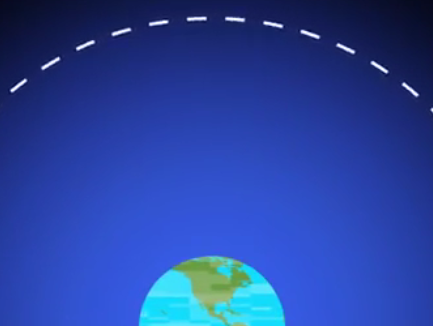Hey there, welcome to Life Noggin! After hearing how Alan Eustace jumped out of a balloon 42 km up and survived,
大家好,欢迎来到打脑洞开的生命奇想!在听说艾伦·尤斯塔斯从42公里高的气球上跳下并幸存下来后,
I started to wonder about what would happen if he had been even higher.
我开始想,如果他飞得更高,会发生什么。
How would his body have handled the extreme conditions of the atmosphere?
他的身体如何应对极端的大气环境?
What if you fell from space to Earth? Let’s go waaay up to the Karman line,
如果你从太空中掉到地球上会怎么样?我们去卡门线上吧,
where space technically begins, 100km above Earth’s surface.
严格来说,那就是太空开始的地方,距离地球表面100公里。
We’re going to jump out of this rocket and find out what happens.
我们要跳出这个火箭,来看看会发生什么。
As you can see, we are immediately knocked unconscious.
正如你看到的,我们立刻昏了过去。
Brain cells need a constant flow of oxygen, which there’s not very much of up here.
脑细胞需要持续不断的氧气,这里却没多少。
So when they don’t get that, the brain goes into a state of hypoxia and kinda just shuts down.
所以大脑没有氧气时就会进入缺氧状态并停止工作。
In serious cases, this can lead to seizures, coma, and even brain death.
在严重的情况下,它会导致癫痫,昏迷,甚至脑死亡。
Also, up here in the thermosphere, we’re being exposed to some very intense X-Rays and UV rays from the sun.
而且,在热大气层,我们暴露在太阳强烈的X射线和紫外线下。
If this alone doesn’t kill us, we’ll likely start vomiting due to radiation poisoning.
如果这还不能杀死我们,我们可能会因为辐射中毒而开始呕吐。
When we get to the mesosphere, which reaches from 85 km above Earth down to 50 km, things don’t get much better.
当我们到达中间层,地球上空85公里到50公里的地方,情况也不会好转。
We’re met with extremely cold temperatures here, almost negative 100 degrees celsius, giving us some serious frostbite!
这里的温度非常低,几乎零下100摄氏度,我们被冻伤了!
But on top of that, the friction of falling this fast from this high up is literally burning through our skin!
但最重要的是,从这么高的高度如此快速地下落所产生的摩擦力会灼伤我们的皮肤!
This is also the layer of the atmosphere where meteors disintegrate.
中间层也是流星分解的大气层。
They leave trails of dust and light behind them, which is what makes them look like shooting stars.
它们在身后留下尘埃和光线的痕迹,这使它们看起来像流星雨。
If you were to fall through the atmosphere, it would kind of look like you’re a human version of a shooting star,
如果你从大气层中坠落,你就会像是人类版的流星,
which doesn't sound fun when you actually think about what's happening.
当你真的想到会发生的事时,就知道这听起来并不好笑。
Next, we’ll enter the stratosphere, which is between 50km to about 15 km above the Earth’s surface.
接下来,我们会进到平流层,它位于地球表面上方50千米到15千米的地方。

There’s a point in the stratosphere above which, your blood starts to boil, around 23 km up.
在平流层中有一个点,在上面大约23千米,你的血液开始沸腾。
At this level of atmospheric pressure, liquids boil at much lower temperatures
在这种大气压下,液体沸腾的温度要低得多,
because the change in pressure of the liquid allows molecules to move more freely between liquid and gas states.
因为液体压力的变化使分子能更自由地在液态和气态之间移动。
The lower the pressure, the quicker it boils. So with low pressure levels at this height and above, your blood boils.
压力越小,沸腾就越快。所以在这个气压水平低的高度,你的血液会沸腾。
It could also happen with other bodily fluids like stomach acid and urine too!
其他体液也会沸腾,如胃酸和尿液!
The troposphere would likely be the least excruciatingly painful of the atmospheric levels.
对流层可能是大气层中最不令人痛苦的地方。
In this layer that stretches about 15 km above the Earth’s surface,
在这个延伸至距地球表面15千米高的地方,
the atmosphere becomes a lot more rich in oxygen and we can finally regain consciousness.
大气中氧气丰富了很多,我们终于可以恢复意识了。
But what next? No one has ever fallen from 100 km up, but people have survived some pretty impressive falls.
但是接下来会怎么样?虽然还没有人从100公里高处坠落,但也有人从一些坠落中幸存下来,令人印象深刻。
Take WWII pilot Alan Magee for example, who survived a fall of 6 km after crashing through a glass roof which absorbed some of the impact.
比如二战飞行员艾伦·马吉,他从6公里的高空摔下,撞穿了一个玻璃屋顶,它吸收了部分冲击力,马吉幸存了下来。
Or Vesna Vulovic whose plane exploded 10km up. She fell to the ground inside a piece of the plane and survived!
或者是韦斯娜·吴罗维克,她的飞机在10千米的高空爆炸。她掉进了飞机的一块残骸里,活了下来!
And it goes without saying, but obviously do not attempt this yourself. I want you to be safe.
这是不言而喻的,但显然你自己不要尝试这样做。我希望你安全。
So, have you ever been skydiving? Would you want to go skydiving?
你曾经跳过伞吗?你想去跳伞吗?
Let me know in the comment section below, or tell us, what should we talk about next?
请在下面的评论区告诉我,或者告诉我们,接下来我们应该讨论什么?


